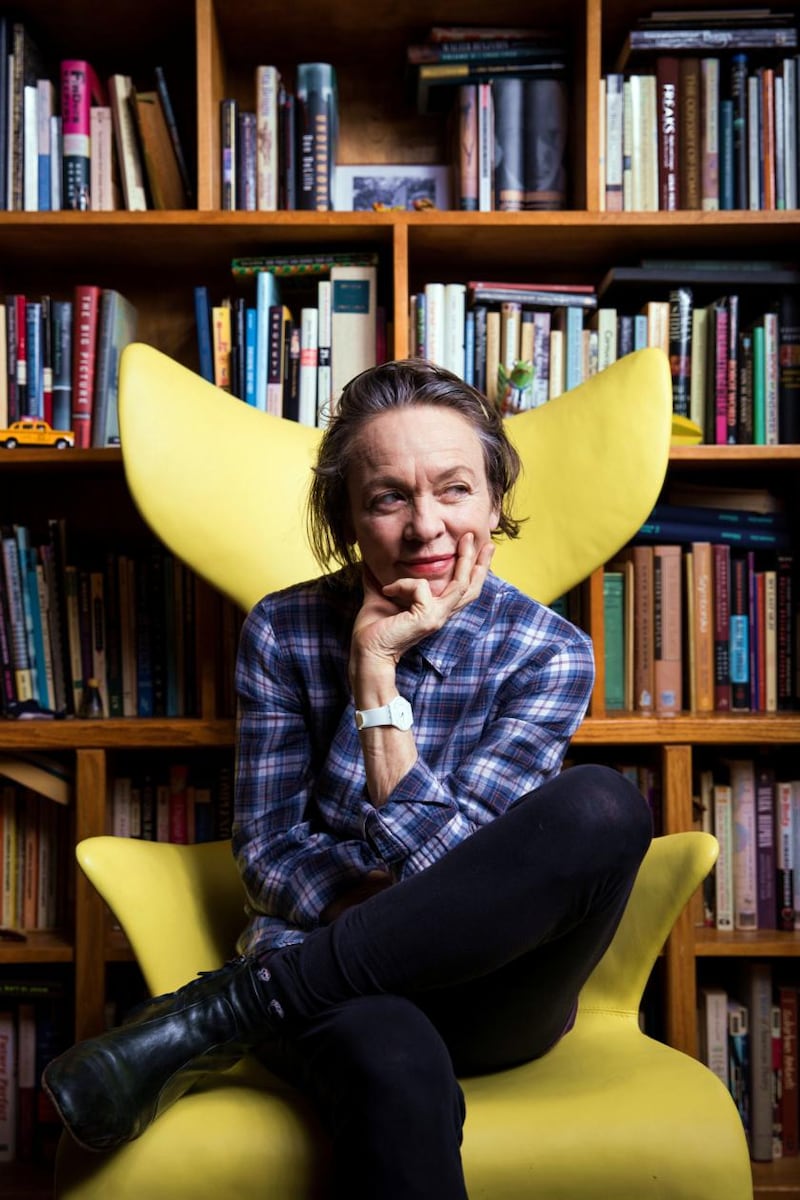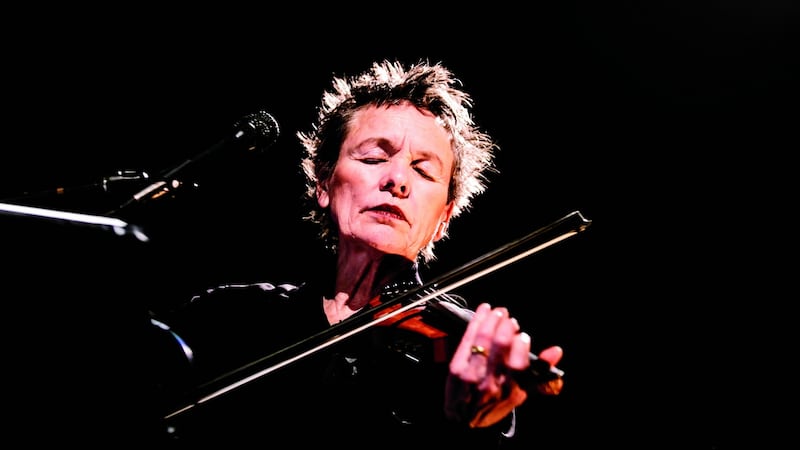It is a beautiful early spring afternoon, full of those surprises of sunshine that make hope seem more like reality when I talk to Laurie Anderson, but she is in the thick of a blizzard. She is at home in Manhattan, immediately liking the idea of our different situations. "I have a great perch right over the Hudson River. It's a very strange blizzard, they're calling it a 'bomb cyclone', they've even weaponised the weather." She says this with a wry laugh. She is also worried about her dog, Little Will, who has been off his food. "He's a border terrier," she says. "It's like living with a cop. When someone comes in, he's, 'who are you? What do you want?'"
Such is Anderson's warmth, I don't for a moment feel that taking her time, in the thick of an explosive blizzard, coupled with pet worries, is any imposition. As our talk ranges from the early days of digital through party planning for Philip Glass to the idea of beauty in everything, the overriding sense she brings is of delight in exploring ideas, and an abiding interest in interconnectedness. Hers is a warmth without sentimentality – a surprisingly rare combination: "We got him [Little Will] right after we lost a dog. What am I saying? You don't lose a dog. Our dog died"; or, on her mother, "I didn't like her very much, actually, but I did really admire her."

We're speaking ahead of Anderson's next visit the National Concert Hall, but first I want to ask her about a memory I have: of her, mesmerising on a Dublin stage, sometime in the 1990s. She was intoning "dot com, dot com", and we were scratching our heads, thinking: what is she on about?
“That must have been Stories from the Nerve Bible,” she says immediately. “I remember it, but I don’t remember where. I was doing a CD-rom with an electric publisher. This was the first time I had even heard of an electric publisher. He was one of the very first – and maybe the last. He did a CD-rom, which is no longer viewable, because there’s nothing to see it on.”
Ubiquity
I like the paradox of a show that prefigured the ubiquity of the internet, but which is hard to pin down in its specifics because it happened ahead of that time. “Imagine if books erased themselves,” agrees Anderson. “It was really interesting to have such a jazzy new medium, and then to go on the road to promote it with that sort of old-school theatre and our music. It was a confusing media point, is what I’m trying to say.”
One of the most magnetic things about Anderson is that she assumes you’re as intelligent as she is. It flatters you into trying to live up to it, but she’s too honest to want to show off to. “I was probably intoning ‘dot com’ as part of that confusion,” she continues. “You know: ‘www dot spectacle, www dot . . .’ People didn’t know what the internet really was.” Again, she laughs at the memory.
Anticipating what the internet could do before it had had even half a chance to start is just one small element of Anderson’s extraordinary career. Now aged 74, she is a singer-songwriter, actor, artist, thinker and creative pioneer. She has had hit singles, kicking off with 1981’s O Superman; written film scores; and has held solo art exhibitions, such as The Weather, currently running at Washington’s Hirshhorn Museum (until July). She has invented musical instruments, and was invited to contribute to an entry on New York for the Encyclopaedia Britannica.
You know your hair is microscopically moving now. We could reconstruct this conversation from your hair
I want to ask her about everything. I want to ask her about being Nasa's first artist-in-residence, about growing up one of eight children in Chicago, about New York in the 1970s and '80s, about inspiration, motivation and the meaning of life. Part of me also wants to ask her about being married to Lou Reed until the singer's death in 2013 – but then I realise that there is so much more to this extraordinary human being than her relationships, intriguing as they may be.
Listening
She tells me about the belief she had as a child, that her walls, the curtains, even the pillow on her bed, were sympathetically listening. “As a kid, I was sure the world was alive in that way.” Then she came across an experiment. “They played a song, quite loud, to a plant. And they filmed the microscopic movements of the plant. I was ecstatic . . .” It turns out that converting sound waves to movement, as captured in light waves, you can convert it back to sound. The song they used was Mary Had a Little Lamb – in honour of Thomas Edison’s 1877 recording of the human voice. When Anderson sings its words, in a deliberately cracked whisper down the phone line, I get a thrilled shiver, even more so when she says, “you know your hair is microscopically moving now. We could reconstruct this conversation from your hair . . .”
When I later try to explain this to my scientist father, he tells me that it’s obvious if you think about it. But that is why art can be such a brilliant element of science: it creates new spaces for abstract yet analytical thought. Some of Anderson’s own brilliance lies in what she chooses to think about, and how she amplifies that attention. Growing up in a family of 10, she says, “you had to compress what you were trying to say, or make it vivid”. It wasn’t full of literary conversation, but “dinner with a lot of noisy kids – saying, Mom, I hope you think I’m smarter than my brother, pay attention to me . . .” Still, she says she’d get out of raking leaves by saying she had to read a book. “That was very respected.” She describes coming downstairs in the middle of the night to discover her mother, wrapped in a blanket, reading, in what was presumably the only quiet time she could find.
The Art of Falling, which Anderson is bringing to the National Concert Hall, evolves with each performance. Previous iterations have involved music, storytelling, tai chi, meditation, improvisation and cello with collaborator and friend Rubin Kodheli. It is hard to pin it down. "Did I call it that? I don't know what I'm going to do. We construct it out of nothing," she says. None of this should be worrying – reviews have been raves.
Interrupted
When we speak, Kodheli and Anderson’s sessions have been interrupted by Covid, but they’re due to play together the next week. “It’s Phil Glass’s 85th birthday. I’m DJing the party at the Rockefeller ice rink. It’s mostly for people to skate around [. . .] Phil Glass never made a piece of music you can’t skate to.”
I try to imagine being there. In the 1970s, Anderson’s acclaimed Duets on Ice performances involved her playing violin while wearing skates encased in ice. The performance ended when the ice was gone.

I wonder if her life, both artistic and personal, follows a plan, or strings of connection and opportunity. “I have lots of plans, and they’re always interrupted by opportunities,” she says. “It’s always good to start with some rules. They clarify, then you realise: that’s much too constricting, I have to find a way around that rule. But as you’re the one that made it, it’s quite easy to break it. We’re such constructions of our own rules, that you forget – who made that rule?”
The idea of rules leads her on to beauty. "Who taught you what beauty is? John Cage says if you see something you don't think is beautiful, it's your problem . . ." And just as I begin to think, yes, but what about all the truly ugly things, she goes on to describe an image of a mink farm. "You can't imagine anything more horrific, except for Auschwitz, but at the same time, if you applied very different filters to it, you would see incredible life force, incredible sunlight dancing off these animals. You would also see they're in absolute agony. Forceful things are happening within those images and in thinking about those things," she says.
A key to this philosophy is the embracing of uncertainty. Something “can suddenly be the loveliest thing you’ve ever seen, and then the most horrific. And you realise it’s not out there, it’s your mind that’s doing it. You’re looking at the ability of your own mind to see it as beautiful – or terrifying.”
Superlatives
In all the superlatives that whirl around the person of Laurie Anderson, one particularly strikes: that she has been called “one of the most important voices of the 20th and 21st centuries”.
If you're afraid to make something because you think you'll be kicked out, you make utilitarian art that sounds like everyone's idea of what is right. And you'll be saying absolutely nothing
“It has probably been 10 years since I read anything about myself,” she says in response. “I don’t do that – and my life began to improve. My friends don’t call me an important voice. Anyway, any kind of hierarchy like that gives me the shivers. What is an unimportant voice?” Instead she has “a tendency to hook on to things. It’s my inner town crier coming out.”
Currently her inner town crier is troubled by cancel culture, and by climate change, and yet she is also against the idea of “art as a method to make the world a better place.” It is, she says, “really inefficient. Anyway, how do you know your belief system is preferable to theirs in terms of what you’re talking about?” Nevertheless, she continues, cancel culture creates “a very dark time for artists. If you’re afraid to make something that isn’t socially good and up to par with all the correct opinions, because you think you’ll be kicked out, you make utilitarian art that sounds like everyone’s idea of what is right. And you’ll be saying absolutely nothing. It’ll be a bunch of little rules. Rules about how we need to behave are essential in some realms. But in the realm of making words and pictures it’s deadly.”
Currently she's reworking an orchestra piece on the death of the aviator Amelia Earhart in a plane crash in 1937. "Now she really did get the art of falling," Anderson notes with lightly dark humour. "The end is a miscommunication between her and a naval warship that was tasked to guide her in. They couldn't see her, but they could hear her. And she could see them, but couldn't hear them. That's how the piece ends, this inability to communicate. She'd run out of gas, and she'd lost her navigation. It's a big factor when you lose your navigator – then you're by yourself."
The way she says it, I’m tempted again to ask about Lou Reed, but we have come to the end of our time, and so the question hangs, along with so many more, evaporating in the suddenly quietened air.





















